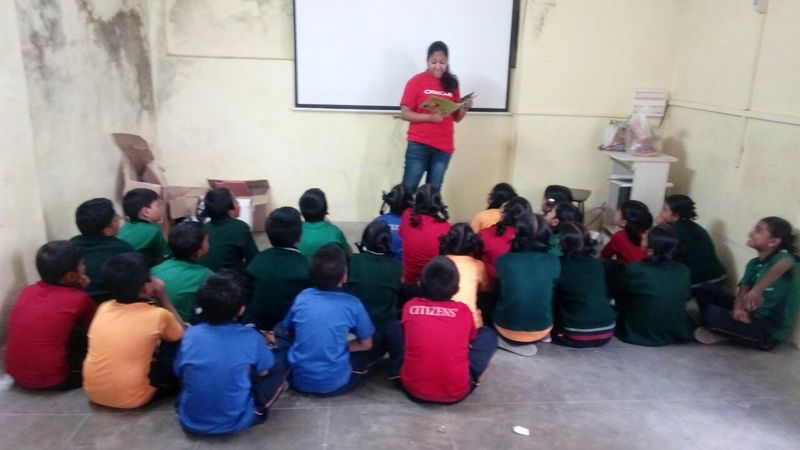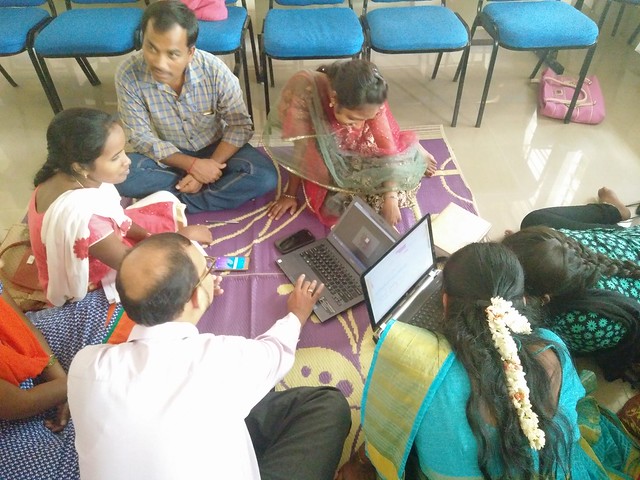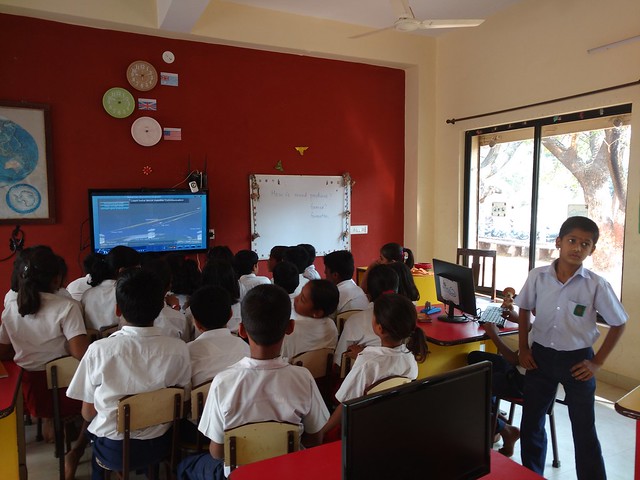A tale of two workshops. StoryWeaver visits Mumbai and Mysore.
Posted by Remya Padmadas on June 16, 2017Khyati Datt, a member of our outreach team writes about two of our recent workshops in Mumbai and Mysore.
It’s not often that you have 25 Master Teachers from different walks of life, speaking 5 different languages, living in 4 different states and still engaging with each other and sharing their thoughts.
This was the scene at our recently conducted StoryWeaver Workshop in Mysore. Pratham Education Foundation invited their wonderful Master Teachers for a training workshop in Mysore and we, at StoryWeaver, got the chance to interact with them on the last day of their training. Our facilitators, Mala, Shruthi and Payoshni ensured that the session was multilingual- in Kannada, Tamil, Telugu, English and Hindi.
The beautiful weather at Mysore served as the perfect setting for a 3-hour long session where interesting teacher practices came to light. As the session progressed, we deep dived into the intriguing world of stories and explored how stories open a child’s eyes to a world filled with joy and learning.
The teachers, then, went on to try their hands at StoryWeaver. They decided on themes and explored the platform for five stories/flashcards that talked about their theme. Their biggest takeaway from this exercise was that they can use the platform in their classrooms and combine storytelling with teaching. The second part of their task was getting down to becoming authors! Each group was given a task sheet with a specific theme and encouraged to create a story/flashcard. The most exciting bit was teachers realizing how easy it is for them to create in their regional languages and taking it to their classrooms back home.
We got some great stories from the teachers, who presented their idea for the story and the flow behind it. With so many tongues in the room, everyone promptly translated what was being spoken in the room which ensured language was not a barrier for a fantastic session of idea-exchanges.
A discussion ensued on what are the different ways in which the teachers can use StoryWeaver in the classrooms. It was wonderful to see how the teachers could align their existing classroom ideas with storytelling practices, like by getting their students excited about a topic by narrating them a story about it. Using illustrations as writing prompts, and spotting books for teaching sight words were one of the many ideas that the teachers dwelled on.
We closed the session by showing the participants videos of teachers using StoryWeaver to build a reading culture in their classrooms. The rain shower that followed was the perfect end to a wonderful workshop!
In the previous week, a similar workshop was conducted in Bombay with 30 teachers from Pratham’s ECE wing from Maharashtra and Gujarat. The crackling energy in the room led to a session that was interactive and fun! The teachers came up with ideas to use stories in the classroom to make the lessons engaging and to ensure that the students learn in a different manner. As Smitin Brid, Program Head of Early Childhood Program for Pratham Education Foundation, puts it, “ I’m thankful to the StoryWeaver team for conducting wonderful and useful sessions at Mumbai and Mysore workshops. The key resource people in both these regions have got information about this platform and we’ll ensure continuous engagement with them on using the resources available on StoryWeaver.”
A big thank you to Pratham Education Foundation and its ECE wing for giving us the opportunity to interact with the teachers and their consistent support.
If you are interested in hosting a similar workshop for your organisation, drop us an email on [email protected]
Be the first to comment.Meet Mantra4Change, the Non-Profit Empowering Teachers and Students to Improve Quality of Education
Posted by Remya Padmadas on February 20, 2017
A quiet, young boy begins to visit his school library every day after classes are over. At first, he goes to just look at the colourful illustrations in the books brought to the school by smiling didis and bhaiyyas. When asked why he stays back, he replies, “This is the world I want to stay in. This makes me happy.” He slowly begins interacting with his fellow students who came to the library abd begins to make friends. The books have opened up his world; at school and beyond. The didis and bhaiyyas who stocked the library are from the NGO, Mantra4Change.
The idea for Mantra4Change took shape in the minds of Khushboo Awasthi and her partner Santosh More in 2010. “Deep inside us was the strong belief that if there is anything that can change the future, it is education. When children don’t have access to quality education their life choices shrink. It was these beliefs that triggered the concept for Mantra4Change.” Khushboo elaborated. At the time, Santosh was a Teach For India (TFI) fellow while Khushboo was pursuing a Masters programme. But they both knew that they wanted to start something of their own in the development sector.
It was 2013 when Khushboo and Santosh founded Mantra4Change and started working on their education project in part-time capacity. In 2014, Santosh joined Mantra4Change full-time and in 2015, Khushboo did the same. They began formally recruiting members through the TFI career portal and Azim Premji University campus recruitment process. In a span of a few years, Mantra4Change has grown from a 2 member team to a small organisation of 12 passionate individuals.
Mantra4Change’s key initiative is ‘STEP’: School Transformation and Empowerment Project. Through STEP and a two-year partnership to ensure its efficacy, Mantra4Change has till date had a positive impact on over 9000 students and 350 teachers in 13 schools. Most of the schools they work with cater to underserved children in the not-so-popular narrow alleys of urban and peri-urban Bengaluru.
A trickle down effect
To effectively implement STEP, the organisation first contacts the head of the school and then works down from there, connecting with each part of the school team on a personal level to understand their needs and challenges. In one of the schools, teachers in the primary school mentioned the need for better books for children to read. Mantra4Change reached out to Pratham Books and helped acquire Library in a Classroom kits. This kind of rapport building, ensures that within 4-6 months 70% of staff are onboard with the programme.
Empowering children
Khushboo and her team believe that students must be empowered and encouraged to step out of their comfort zone. She shared a story of how 12 students from Mantra4Change partner schools attended an International Geography Youth Summit.
“We had to convince the teachers that the children were indeed ready to take the stage. At the conference, to the surprise and delight of the children, two of their groups got standing ovations from the audience. When they came back, you could see the confidence in them. They came up to the team and their teachers, and said, ‘thank you so much, ma’am, for giving us this opportunity. We would never have experienced this.’ We saw an an opportunity and took it to our students and they grabbed onto it. It’s their hard work at the end of the day.” remembers Khushboo.
Joyful reading material in their mother tongue
Under STEP, Mantra4Change is also implementing a library programme in which they set up libraries to make books more accessible to children. Mantra4Change has teamed up with Pratham Books to provide the children colourfully illustrated, multilingual stories. Describing the books and the library programme, one student told us, “The illustrations are very nice, the story is funny!” adding that she had begun reading at home more after the library had been set up.
In addition to the libraries, content from StoryWeaver is downloaded onto computers in the library for children to read and enjoy. There is an added excitement when the children get to read the e-books on the computers. Mrs. Morris, a librarian who conducts weekly storytelling sessions at the Citizen’s School, Bengaluru said, "The e-books work like a reward. The kids love operating the computer because they do not get a lot of opportunities to do so otherwise. I use the e-books for partner reading and it is working great. Children read, then discuss what they read. This helps develop their comprehension and communication abilities.”
“The whole atmosphere in the library when the children come is magical! Even those who can’t read fluently yet like to come and touch the books, see the pictures and make up their own stories using their imagination. It’s beautiful to see.” Khushboo added.
Mantra4Change’s passionate team is determined to make a difference in the lives and learning of the children in the schools they work with “Our team is here because they really want to make a change and affect education at the school level.” Mantra4Change hopes to double the number of schools they work with as well as the team’s size by May 2017. We’re sure they’ll get there, one step at a time!
Be the first to comment.How Story Time Is Making Learning Fun for 30,000 Students in Maharashtra’s Govt Schools
Posted by Remya Padmadas on June 19, 2017In the hilly terrains of Phaltan, Satara district, Maharashtra a movement to seed the joy of reading in classrooms is being quietly seeded in 150 Zilla Parishad schools.
Pragat Shikshan Sanstha is an educational enterprise that supports schools, teachers and children in the district of Phaltan and other nearby areas. The organisation works with students through their own flagship school and after school programmes, and also trains teachers in good educational practices in government schools. By engaging researchers, government officials and the general public in an ongoing dialogue Pragat Shikshan Sanstha hopes to positively impact the education ecosystem.
“We are trying to impact the educational ecosystem by changing the image of ‘the child’ and ‘the teacher’ through excellent classroom practices, sound pedagogies, elements of classroom research and education for equality.” Manjiri Nimbkar, Secretary, Pragat Shikshan Sanstha.
Drop Everything and Read
One of Pragat Shikshan Sanstha’s areas of focus is setting up more libraries in the region. This, they felt was something that would not only benefit the schools in the area but also children from other nearby communities. The organisation felt that it was imperative to make books and read aloud sessions a part of their training offering to teachers. The idea was to get more teachers to use more books in their classrooms and libraries through read alouds and storytelling sessions.
Reading in so important in early childhood as books can free a child, and give them the opportunity to think and imagine. By helping children express themselves in varied ways, books encourage them to understand and empathise with the lives and experiences of those who are marginalised.
Pragat Shikshan Sanstha came across StoryWeaver - a digital repository of multilingual stories for children from Pratham Books and in it, discovered a source of stories in Marathi, the language of the region. All content on StoryWeaver is openly licensed under CC-BY4.0 and can be read, translated, downloaded, printed and shared for free. Through StoryWeaver, the organisation has access to many joyful stories in Marathi but without having to heavily invest in buying books regularly.
It’s story time!
Pragat Shikshan Sanstha curated a list of stories, in different levels across a variety of themes and topics and circulated it amongst the teachers who were being trained in using storytelling as a medium for language development.
These teachers also double up as librarians! The teachers choose from the circulated list the stories they think will work best for their students, downloaded them as per their class’s requirement and conduct read aloud sessions. Each library is equipped with a tablet and a projector which the teachers use to project stories off StoryWeaver. They also conduct various activities - art & craft, book reviews, games, skits etc around the books to help extend learning.
Pratham Books was fortunate to watch one of these wonderful sessions at a Zilla Parishad schools in the region. The classroom was equipped with a projector donated by a local badminton association and some computers (in working condition) from a corporate.
Bohra Bai, who teaches grades 2 and 3 in the school, first did a little warm up with the children before asking them to sit down. The story she had chosen that day was ‘Sam’s Christmas Present’ by Annie Besant and Alicia D’Souza in Marathi. Bohra Bai started from the cover page and urged the children to note everything that was there on the cover and predict what could the book be about. She got them to make connections, relate it to their own lives and pointed out sight words. Basically, everything you would expect a good teacher to do with a good book.
“We have regular sessions with teachers on how good read alouds are done, what are the different activities one can do with the books and the teachers value these training.”
When we took Bohra Bai aside to ask her a few question, young Diksha took over and continued to read the story aloud to her classmates, and did a tremendous job of it!
“Storybooks with illustrations help children imagine and understand better, along with learning about new cultures or things they don't see otherwise. For example with this book Sam's Christmas Present, they got to know about the festival of Christmas or the food that is eaten during Christmas as children from villages have never seen or eaten things like that.” shared Bohra Bai.
When asked about using technology in the classroom, she had this to say: “Projecting stories help catch children's attention better because this is new for them. Its interesting because it looks like TV to them.”
Stories can be an excellent tool in the classroom, an idea Bohra Bai strongly agrees with! “Stories really help children expand their vocabulary. For example, they get to know options of words in proper language that they use otherwise in their day to day lives, in dialects of that language. This really helps language development.”
A total of 150 Government schools in the Phaltan district have libraries & digital set up from PSS. About 30000 children from Grades 2 to 7, get to listen, read and enjoy stories in Marathi and Hindi.
“Going forward we hope to create more books for children with imaginative illustrations and help people understand the importance of illustrations. Create literature to help children understand and tackle issues and problems. Encourage children’s own creative writing.”
Be the first to comment.
